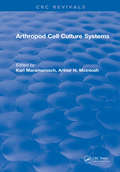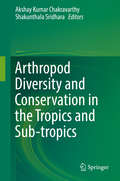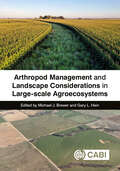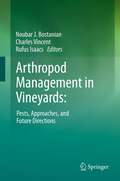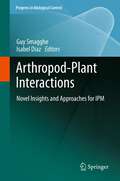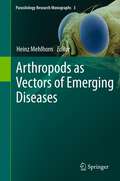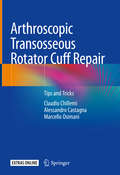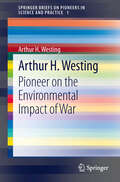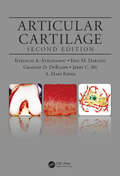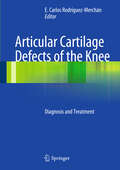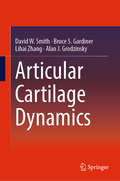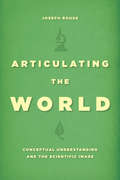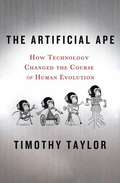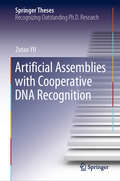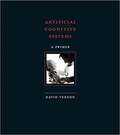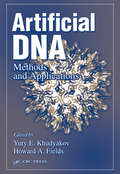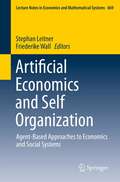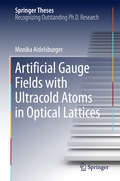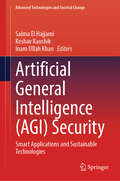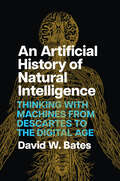- Table View
- List View
Arthropod Borne Diseases
by Carlos Brisola MarcondesArthropod borne diseases cause enormous morbidity and mortality in most countries, mostly in those situated in tropical areas, but also in temperate regions. This book provides organized information on all arthropod related diseases, to prevent suffering and deaths, for medical students and professionals. Since arthropod borne diseases are present in many regions of the world and can even surprise professionals and lays in non-endemic regions, like malaria in UK and Canada, the author and its many expert collaborators are sure that it will be essential in all hospitals, clinics and medical libraries around the world. As arthropod borne diseases of domesticated animals are very numerous and in some cases related to human diseases, they are also included in the book.
Arthropod Cell Culture Systems
by Karl MaramoroschInvertebrate cell culture is increasingly being used in various areas of biological research. Research in cellular biology and pathology that previously depended primarily on in vitro investigations of vertebrate animal cell systems is now being conducted using invertebrate cells. Specialists and pioneers from the United States, Japan, Switzerland, Slovakia, and China have presented original contributions to create a well-balanced cross-section of current developments. Topics discussed include the preparation of cell culture media; cultivation of mosquito, lepidopteran, grasshopper, and tick cells; the application of such cells to mammalian and plant virus research; and diverse applications in medicine, biology, and agriculture. A special chapter devoted to the work of Japanese cell culture pioneers is also featured. All chapters are supported by tables, photographs, and up-to-date bibliographies.
Arthropod Diversity and Conservation in the Tropics and Sub-tropics
by Akshay Kumar Chakravarthy Shakunthala SridharaArthropods are invertebrates that constitute over 90% of the animal kingdom, and their bio-ecology is closely linked with global functioning and survival. Arthropods play an important role in maintaining the health of ecosystems, provide livelihoods and nutrition to human communities, and are important indicators of environmental change. Yet the population trends of several arthropods species show them to be in decline. Arthropods constitute a dominant group with 1. 2 million species influencing earth's biodiversity. Among arthropods, insects are predominant, with ca. 1 million species and having evolved some 350 million years ago. Arthropods are closely associated with living and non-living entities alike, making the ecosystem services they provide crucially important. In order to be effective, plans for the conservation of arthropods and ecosystems should include a mixture of strategies like protecting key habitats and genomic studies to formulate relevant policies for in situ and ex situ conservation. This two-volume book focuses on capturing the essentials of arthropod inventories, biology, and conservation. Further, it seeks to identify the mechanisms by which arthropod populations can be sustained in terrestrial and aquatic ecosystems, and by means of which certain problematic species be managed without producing harmful environmental side-effects. This edited compilation includes chapters contributed by over 80 biologists on a wide range of topics embracing the diversity, distribution, utility and conservation of arthropods and select groups of insect taxa. More importantly, it describes in detail the mechanisms of sustaining arthropod ecosystems, services and populations. It addresses the contribution of modern biological tools such as molecular and genetic techniques regulating gene expression, as well as conventional, indigenous practices in arthropod conservation. The contributors reiterate the importance of documenting and understanding the biology of arthropods from a holistic perspective before addressing conservation issues at large. This book offers a valuable resource for all zoologists, entomologists, ecologists, conservation biologists, policy makers, teachers and students interested in the conservation of biological resources.
Arthropod Management and Landscape Considerations in Large-Scale Agroecosystems
by Matthew O'Neal Steven E. Naranjo Ian MacRae Kristopher L Giles Tom Royer Peter C Ellsworth Kristen Baum Mahendra Bhandari Haley Butler Hannalene Du Plessis Norman C. Elliott Sarah Elzay Isaac L. Esquivel Ashleigh M. Faris Aaron J. Gassmann Maura Hall Louis S. Hesler Anders S. Huseth William D. Hutchison Robert L. Meagher Jr Lance J. Meinke Shannon L. Osborne Pankaj Pal Katherine A. Parys Dominic Reisig Nina Rudin Thomas W. Sappington Gregory A. Sword Ashley E. Tessnow Paul A. Umina Johnnie Van BergFor large-scale agroecosystems, patterns of pest population increases (graded increases or abrupt outbreaks) and declines (graded suppression or abrupt crashes) vary considerably and are influenced by factors within crop fields and across broader landscape scales. Better understanding of pest population dynamics and the implications of spatial interactions on the function and development of pest management approaches are the main themes of this important book. The book builds from a 60+ year history of field-based pest management by focusing on the drivers of pest management in large-scale agroecosystems and the landscape-scale processes that affect these drivers and contribute to variation in pest outbreaks and suppression. These drivers include abiotic and biotic influences such as weather, spatial composition and arrangement of landscape elements, and widely applied managed inputs such as planting and crop rotation schedules, crop varietal selection, and land and soil conservation efforts. The book introduces general concepts, opportunities, and challenges of arthropod management in large-scale agroecosystems. Case studies from major field crop-based agroecosystems are used to present research approaches and improve understanding and management of pest and beneficial insects in large-scale agroecosystems. Specific research findings are provided on multi-trophic interactions within the system as influenced by climate, landscape, and other ecological, agricultural, and social/economic components of the agroecosystem. The book concludes with a synthesis of these concepts and prospectus for future research and developments in arthropod management in large-scale, plant-based agroecosystems. The book is essential reading for researchers in applied entomology and ecology and for pest management practitioners.
Arthropod Management in Vineyards: Pests, Approaches, and Future Directions
by Charles Vincent Rufus Isaacs Noubar J. BostanianProvides a state-of-the-science overview of arthropods affecting grape production around the world. Vineyard pest management is a dynamic and evolving field, and the contributed chapters provide insights into arthropods that limit this important crop and its products. Written by international experts from the major grape-growing regions, it provides a global overview of arthropods affecting vines and the novel strategies being used to prevent economic losses, including invasive pests affecting viticulture. The book contains reviews of the theoretical basis of integrated pest management, multiple chapters on biological control, current status of chemical control, as well as in-depth and well-illustrated reviews of the major arthropod pests affecting grape production and how they are being managed worldwide. This text will serve as a primary resource for applied entomologists, students, growers, and consultants with interests at the intersection of viticulture and applied entomology.
Arthropod-Plant Interactions: Novel Insights and Approaches for IPM (Progress in Biological Control #14)
by Guy Smagghe Isabel DiazThe book consists of multiple chapters by leading experts on the different aspects in the unique relationship between arthropods and plants, the underlying mechanisms, realized successes and failures of interactions and application for IPM, and future lines of research and perspectives. Interesting is the availability of the current genomes of different insects, mites and nematodes and different important plants and agricultural crops to bring better insights in the cross talk mechanisms and interacting players. This book will be the first one that integrates all this fascinating and newest (from the last 5 years) information from different leading research laboratories in the world and with perspectives from academia, government and industry.
Arthropods as Vectors of Emerging Diseases: Arthropods As Vectors Of Emerging Diseases (Parasitology Research Monographs #3)
by Heinz MehlhornGlobal warming and globalization are the buzzwords of our time. They have nearly reached a religious status and those who deny their existence are considered modern heretics. Nevertheless, the earth has become an overcrowded village, traversable within a single day. Thus it is hardly surprising that besides persons and goods also agents of disease are easily transported daily from one end of the world to the other, threatening the health and lives of billions of humans and their animals. Agents of diseases (prions, viruses, bacteria, fungi and parasites) are not only transmitted by body contact or direct exchange of bodily fluids, but also by means of vectors which belong to the groups of licking or blood-sucking arthropods (mites, ticks, insects) that live close to humans and their houses. Without a doubt the recently accelerating globalization supports the import of agents of disease into countries where they never had been or where they had long since been eradicated, leading to a false sense of living on a "safe island." These newly imported or reintroduced diseases - called "emerging diseases" - may lead to severe outbreaks in cases where the countries are not prepared to combat them, or in cases where viruses are introduced that cannot be controlled by medications or vaccines. Arthropods are well known vectors for the spread of diseases. Thus their invasion from foreign countries and their spreading close to human dwellings must be blocked everywhere (in donor and receptor countries) using safe and effective measures. This book presents reviews on examples of such arthropod-borne emerging diseases that lurk on the fringes of our crowded megacities. The following topics show that there is an ongoing invasion of potential vectors and that control measures must be used now in order to avoid disastrous outbreaks of mass diseases.
Arthroscopic Transosseous Rotator Cuff Repair: Tips and Tricks
by Claudio Chillemi Alessandro Castagna Marcello OsimaniThe book offers a comprehensive and up-to-date guide to the cutting edge arthroscopic transosseous techniques for the treatment of rotator cuff tears, which are gradually taking over from the common open surgical approach, defined as the gold standard for RCR. With the help of numerous figures, it presents step by step a novel all-arthroscopic anchorless transosseous suture technique that is less invasive and easier to perform. After discussing the etiopathogenesis, histopathology and radiological classification of rotator cuff tears, the book reviews all possible arthroscopic procedures and explores in detail suture management, describing single and double tunnel options. It also examines the complications and post-operative rehabilitation and imaging, while the closing chapter addresses the economic aspects of daily use. Intended primarily for arthroscopic surgeons interested in the field of shoulder joint repair, this exhaustive guide is also a valuable resource for residents and shoulder specialists.
Arthur E. Haas - The Hidden Pioneer of Quantum Mechanics: A Biography (Springer Biographies)
by Michael WiescherThe book highlights the personal and scientific struggles of Arthur Erich Haas (1884-1941), an Austrian Physicist from a wealthy Jewish middle-class family, whose remarkable accomplishments in a politically hostile but scientifically rewarding environment deserve greater recognition.Haas was a fellow student of both Lise Meitner and Erwin Schrödinger and was also one of the last doctoral students of Ludwig Boltzmann. Following Boltzmann's suicide, Haas was forced to submit a more independent doctoral thesis in which he postulated new approaches in early quantum theory, actually introducing the idea of the Bohr radius before Niels Bohr. It is the lost story of a trailblazer in the fields of quantum mechanics and cosmology, a herald of nuclear energy and applications of modern science. This biography of Haas is based on new and previously unpublished family records and archived material from the Vienna Academy of Science and the University of Notre Dame, which the author has collected over many years. From his analysis of the letters, documents, and photos that rested for nearly a century in family attics and academic archives, Michael Wiescher provides a unique and detailed insight into the life of a gifted Jewish physicist during the first half of the twentieth century. It also sheds light on the scientific developments and thinking of the time. It appeals not only to historians and physicists, but also general readers. All appreciate the record of Haas’ interactions with many of the key figures who helped to found modern physics.
Arthur H. Westing: Pioneer on the Environmental Impact of War (SpringerBriefs on Pioneers in Science and Practice #1)
by Arthur H. WestingSince the 1960s the environment has become an issue of increasing public concern in North America and elsewhere. Triggered by the Second Indochina War (Vietnam Conflict) of 1961-1975, and further encouraged by the International Conference on the Human Environment, held in Stockholm in 1972, the environmental impact of war emerged and grew as a topic of research in the natural and the social sciences. And in the late 1980s this led additionally to a focus and debate on environmental security. Arthur Westing, a forest ecologist, was a major pioneer contributing and framing both of those debates conceptually, theoretically, and empirically, starting with Harvest of Death: Chemical Warfare in Vietnam and Cambodia (1972) (co-authored with wildlife biologist E.W. Pfeiffer and others). As a Senior Researcher at the Stockholm and Oslo International Peace Research Institutes (SIPRI and PRIO), and as a Professor of Ecology at Windham and Hampshire Colleges, Westing authored and edited books on Ecological Consequences of the Second Indochina War (1976), Weapons of Mass Destruction and the Environment (1977), Warfare in a Fragile World: Military Impact on the Human Environment (1980), Herbicides in War: the Long-term Ecological and Human Consequences (1984), Environmental Warfare: a Technical, Legal and Policy Appraisal (1984), Explosive Remnants of War: Mitigating the Environmental Effects (1985), Global Resources and International Conflict: Environmental Factors in Strategic Policy and Action (1986), Cultural Norms, War and the Environment (1988), Comprehensive Security for the Baltic: an Environmental Approach (1989), and Environmental Hazards of War: Releasing Dangerous Forces in an Industrialized World (1990) --- as well as authoring numerous UN reports, book chapters, and journal articles. This volume combines six of his pioneering contributions on the environmental consequences of warfare in Viet Nam and in Kuwait, on the environmental impact of nuclear war, and on legal constraints and military guidelines for protecting the environment in wartime
Arthur M. Sackler COLLOQUIA OF THE NATIONAL ACADEMY OF SCIENCES: Self-Organized Complexity in the Physical, Biological, and Social Sciences
by National Academies of Sciences EngineeringThe National Academies Press (NAP)--publisher for the National Academies--publishes more than 200 books a year offering the most authoritative views, definitive information, and groundbreaking recommendations on a wide range of topics in science, engineering, and health. <P><P>Our books are unique in that they are authored by the nation's leading experts in every scientific field.
Arthur M.Sackler COLLOQUIA OF THE NATIONAL ACADEMY OF SCIENCES: Neural Signaling
by National Academy of ScienceThe National Academies Press (NAP)--publisher for the National Academies--publishes more than 200 books a year offering the most authoritative views, definitive information, and groundbreaking recommendations on a wide range of topics in science, engineering, and health.<P><P> Our books are unique in that they are authored by the nation's leading experts in every scientific field.
Articular Cartilage (Synthesis Lectures On Tissue Engineering Ser.)
by Kyriacos A. Athanasiou Eric M. Darling Jerry C. Hu Grayson D. DuRaine A. Hari ReddiThis book covers the latest research and advancements related to articular cartilage in biology, development, pathology, clinical applications and tissue engineering. The authors take an interdisciplinary approach that encompasses the breadth and depth of basic science, bioengineering, translational science and detailed methological approaches. It is designed to be an all encompassing encyclopedia of articular cartilage. Written at a level that allows wide accessibility, the book’s comprehensive focus on multiple aspects of articular cartilage sets it apart from other books.
Articular Cartilage Defects of the Knee: Diagnosis and Treatment
by E. Carlos Rodrìguez-MerchánThis book reviews current knowledge on the diagnosis and treatment (surgical and non-surgical) of cartilage defects at the knee joint. In the discussion of diagnosis, the focus is primarily on imaging findings, particularly those obtained with MRI. The remainder of the book is devoted to the full range of current conservative and surgical treatments, with attention to both treatment indications and results as reported in the recent literature. In reviewing non-surgical treatment, oral and intra-articular medical management is evaluated and rehabilitation and physical therapy are also considered. The three main types of surgical technique - microfracture surgery and similar procedures, mosaicplasty and related techniques, and autologous chondrocyte transplantation - are then extensively discussed in a series of highly informative chapters. This book will be of great practical value for clinicians, assisting in daily decision making.
Articular Cartilage Dynamics (Series in BioEngineering)
by David W. Smith Bruce S. Gardiner Lihai Zhang Alan J. GrodzinskyThis book explains the anatomy and physiology of cartilage tissue in an integrated way. The emphasis is on how cartilage tissue functions and maintains homeostasis in a challenging mechanical environment. Supported by hundreds of references, the book posts new hypotheses explaining how cartilage adapts and achieves homeostasis in vivo, and tests them against available data. This exploratory approach creates a sense of discovery that the reader can join, or perhaps test themselves through their own research. The main benefit will be obtained by research students and professors looking to understand the deeper concepts that will further their own research, or clinicians (including health professionals and surgeons) who want to gain a deeper physiological understanding of cartilage tissue, which can then serve as a basis for more rational clinical decision-making they need to make on a daily basis. To help bridge the gap between basic science and clinically relevant joint disease, applications and interpretations of key physiological concepts are discussed in the context of osteoarthritis at the end of most chapters.
Articulating Difference: Sex and Language in the German Nineteenth Century
by Sophie SalvoEnriches contemporary debates about gender and language by probing the histories of the philosophy and sciences of language. Drawing on a wide range of texts, from understudied ethnographic and scientific works to canonical literature and philosophy, Sophie Salvo uncovers the prehistory of the inextricability of gender and language. Taking German discourses on language as her focus, she argues that we are not the inventors but, rather, the inheritors and adapters of the notion that gender and language are interrelated. Particularly during the long nineteenth century, ideas about sexual differences shaped how language was understood, classified, and analyzed. As Salvo explains, philosophers asserted the patriarchal origins of language, linguists investigated “women’s languages” and grammatical gender, and literary Modernists imagined “feminine” sign systems, and in doing so they not only deemed sex-based divisions to be necessary categories of language but also produced a plethora of gendered tropes and fictions, which they used both to support their claims and delimit their disciplines. Articulating Difference charts new territory, revealing how gendered conceptions of language make possible the misogynistic logic of exclusion that underlies arguments claiming, for example, that women cannot be great orators or writers. While Salvo focuses on how male scholars aligned language study with masculinity, she also uncovers how women responded, highlighting the contributions of understudied nineteenth-century works on language that women wrote even as they were excluded from academic opportunities.
Articulating the World: Conceptual Understanding and the Scientific Image
by Joseph RouseNaturalism as a guiding philosophy for modern science both disavows any appeal to the supernatural or anything else transcendent to nature, and repudiates any philosophical or religious authority over the workings and conclusions of the sciences. A longstanding paradox within naturalism, however, has been the status of scientific knowledge itself, which seems, at first glance, to be something that transcends and is therefore impossible to conceptualize within scientific naturalism itself. In Articulating the World, Joseph Rouse argues that the most pressing challenge for advocates of naturalism today is precisely this: to understand how to make sense of a scientific conception of nature as itself part of nature, scientifically understood. Drawing upon recent developments in evolutionary biology and the philosophy of science, Rouse defends naturalism in response to this challenge by revising both how we understand our scientific conception of the world and how we situate ourselves within it.
The Artificial Ape: How Technology Changed the Course of Human Evolution
by Timothy TaylorWhile Darwin's theory explains our common descent, scientists have grappled with the reasons why human evolution defies the principles of natural selection and why, although we dominate the planet, we have become the weakest ape. In this fascinating narrative, leading archaeologist Timothy Taylor proposes that it was our early adoption of tools, objects, and, now, technology that changed us, demonstrating how: baby slings made out of animal fur freed up our arms up to use tools; clothes kept us warm, reducing our need for body hair; shelter protected us from the elements and led our bodies to become slighter and physically weaker. Drawing on the latest fossil evidence, Taylor shows how humans made choices that assumed greater control over their own evolution.
Artificial Assemblies with Cooperative DNA Recognition (Springer Theses)
by Zutao YUThis book presents three types of synthetically cooperative DNA recognizing assemblies, in order to advance the development of programmable DNA-binding pyrrole–imidazole polyamides (PIPs). PIPs represent the best-characterized class of small molecule DNA binders that can be modified to bind with any predetermined DNA sequence and regulate gene expression patterns in a transgene-free and cost-effective manner. PIPs are characterized by their small molecular size, high binding affinity, programmability, sequence selectivity, and moderate cell permeability. In recent years, there have been numerous novel studies on the applications of these biological tools; this research is thoroughly reviewed in the first chapter. There are several critical issues, however, that impede the further broad study of PIPs, which greatly concern the author. For instance, the short PIP version has an excessively hi^10 bp; this significantly decreases cell permeability. Moreover, the conventional binding strategy for PIP design cannot apply to flexible DNA binding—for example, the DNA-binding mode of a transcription factor pair. In this book, the author describes the development of three kinds of cooperative DNA-binding systems that help resolve the current highly problematic issues concerning PIPs. These three systems offer a range of significant advantages, such as favorable sequence selectivity, long recognition sequence, higher binding affinity, and a flexible gap distance. Released at a critical juncture in the application of PIPs, this book will greatly facilitate their use as therapeutic drugs in the treatment of cancer and hereditary diseases, and in regenerative medicine.
Artificial Cognitive Systems: A Primer
by David VernonA concise introduction to a complex field, bringing together recent work in cognitive science and cognitive robotics to offer a solid grounding on key issues. <p><p> This book offers a concise and accessible introduction to the emerging field of artificial cognitive systems. Cognition, both natural and artificial, is about anticipating the need for action and developing the capacity to predict the outcome of those actions. Drawing on artificial intelligence, developmental psychology, and cognitive neuroscience, the field of artificial cognitive systems has as its ultimate goal the creation of computer-based systems that can interact with humans and serve society in a variety of ways. This primer brings together recent work in cognitive science and cognitive robotics to offer readers a solid grounding on key issues. <p><p> The book first develops a working definition of cognitive systems―broad enough to encompass multiple views of the subject and deep enough to help in the formulation of theories and models. It surveys the cognitivist, emergent, and hybrid paradigms of cognitive science and discusses cognitive architectures derived from them. It then turns to the key issues, with chapters devoted to autonomy, embodiment, learning and development, memory and prospection, knowledge and representation, and social cognition. Ideas are introduced in an intuitive, natural order, with an emphasis on the relationships among ideas and building to an overview of the field. The main text is straightforward and succinct; sidenotes drill deeper on specific topics and provide contextual links to further reading.
Artificial DNA: Methods and Applications
by Yury E. Khudyakov Howard A. FieldsCombining elements of biochemistry, molecular biology, and immunology, artificial DNA can be employed in a number of scientific disciplines. Some of the varied applications include site-specific mutagenesis, hybridization, amplification, protein engineering, anti-sense technology, DNA vaccines, protein vaccines, recombinant antibodies, screening fo
Artificial Economics and Self Organization: Agent-Based Approaches to Economics and Social Systems (Lecture Notes in Economics and Mathematical Systems #669)
by Stephan Leitner Friederike WallThis volume presents recent advances in the dynamic field of Artificial Economics and its various applications. Artificial Economics provides a structured approach to model and investigate economic and social systems. In particular, this approach is based on the use of agent-based simulations and further computational techniques. The main aim is to analyze the outcomes at the overall systems' level as results from the agents' behavior at the micro-level. These emergent characteristics of complex economic and social systems can neither be foreseen nor are they intended. The emergence rather makes these systems function. Artificial Economics especially facilitates the investigation of this emergent systems' behavior.
Artificial Gauge Fields with Ultracold Atoms in Optical Lattices (Springer Theses)
by Monika AidelsburgerThis work reports on the generation of artificial magnetic fields with ultracold atoms in optical lattices using laser-assisted tunneling, as well as on the first Chern-number measurement in a non-electronic system. It starts with an introduction to the Hofstadter model, which describes the dynamics of charged particles on a square lattice subjected to strong magnetic fields. This model exhibits energy bands with non-zero topological invariants called Chern numbers, a property that is at the origin of the quantum Hall effect. The main part of the work discusses the realization of analog systems with ultracold neutral atoms using laser-assisted-tunneling techniques both from a theoretical and experimental point of view. Staggered, homogeneous and spin-dependent flux distributions are generated and characterized using two-dimensional optical super-lattice potentials. Additionally their topological properties are studied via the observation of bulk topological currents. The experimental techniques presented here offer a unique setting for studying topologically non-trivial systems with ultracold atoms.
Artificial General Intelligence: Smart Applications and Sustainable Technologies (Advanced Technologies and Societal Change)
by Keshav Kaushik Inam Ullah Khan Salma El HajjamiThis book highlights a collection of state-of-the-art research on Safe Artificial General Intelligence (AGI), highlighting the crucial role of cybersecurity, smart applications, and sustainable technologies in ensuring a secure AI future. It illustrates the latest trends in AI safety, exploring the potential risks and dangers associated with AGI development and ways to prevent unintended consequences. The book discusses the convergence of various fields, such as AI, cybersecurity, smart applications, and sustainable technologies, by providing an overview of theoretical, practical, and simulation concepts of AGI. It also displays solutions that will help mitigate the risks and ensure the responsible and ethical development of AGI. It provides insights and perspectives from experts in these fields and offers a comprehensive guide to understanding the challenges and opportunities associated with the development of safe and secure AGI. The book includes chapters on various topics related to AGI security, including the ethical and legal aspects of AGI development, the role of explainability in ensuring transparency and accountability, the use of machine learning for intrusion detection and prevention, and the application of smart technologies for securing AGI systems. Additionally, it explores the impact of sustainable technologies on AGI security, such as the use of renewable energy sources to power AGI systems and the development of eco-friendly hardware. This book is a valuable source for researchers, students, and practitioners interested in the fields of artificial general intelligence, cybersecurity, smart applications, and sustainable technologies.
An Artificial History of Natural Intelligence: Thinking with Machines from Descartes to the Digital Age
by David W. BatesA new history of human intelligence that argues that humans know themselves by knowing their machines. We imagine that we are both in control of and controlled by our bodies—autonomous and yet automatic. This entanglement, according to David W. Bates, emerged in the seventeenth century when humans first built and compared themselves with machines. Reading varied thinkers from Descartes to Kant to Turing, Bates reveals how time and time again technological developments offered new ways to imagine how the body’s automaticity worked alongside the mind’s autonomy. Tracing these evolving lines of thought, An Artificial History of Natural Intelligence offers a new theorization of the human as a being that is dependent on technology and produces itself as an artificial automaton without a natural, outside origin.

